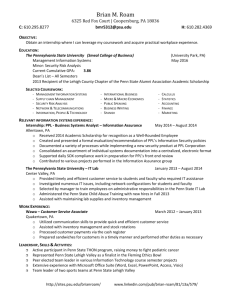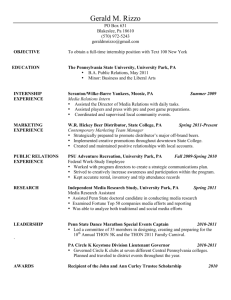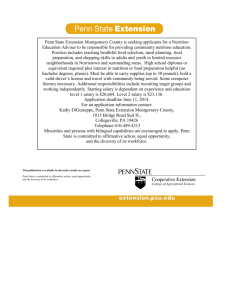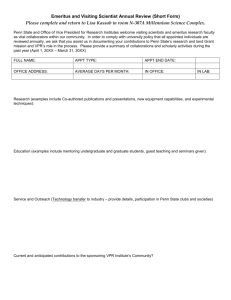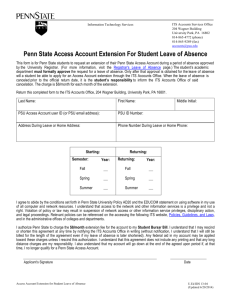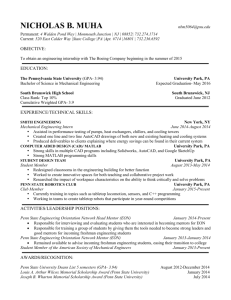Internet Resource Guide for Mechanical Engineering Students
advertisement
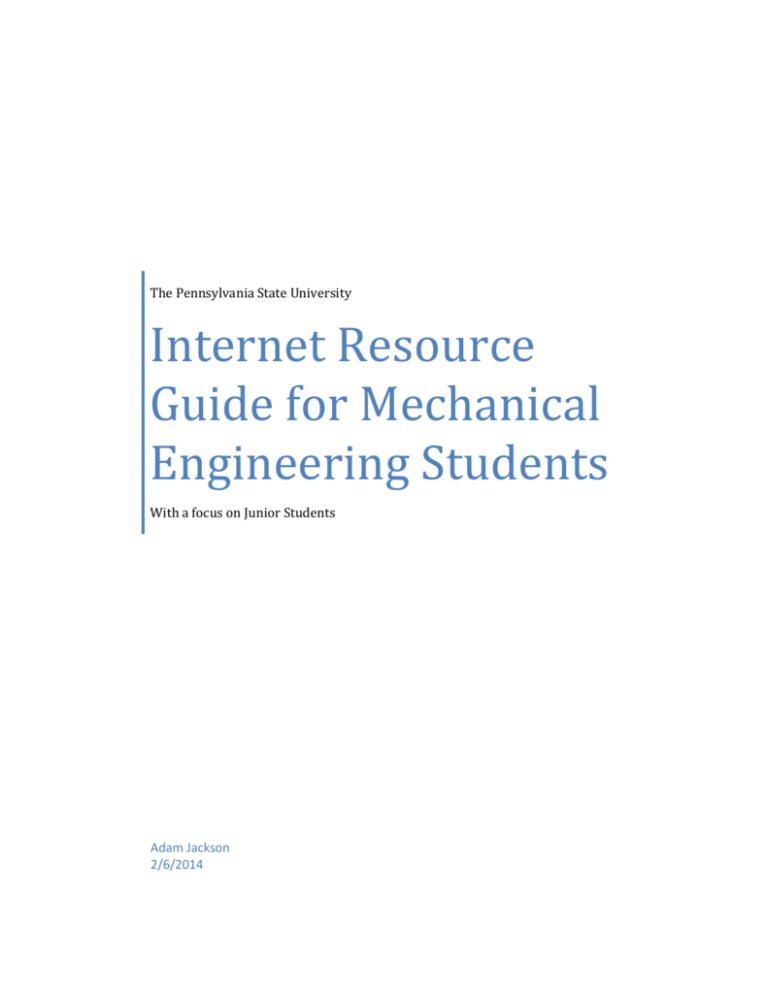
The Pennsylvania State University Internet Resource Guide for Mechanical Engineering Students With a focus on Junior Students Adam Jackson 2/6/2014 Table of Contents Introduction .................................................................................................................................................. 1 What’s in the Guide ............................................................................................................................... 1.1 Who the Guide is for .............................................................................................................................. 1.2 What the Guide Assumes Users Know ................................................................................................... 1.3 How the Guide is Organized for Use ...................................................................................................... 1.4 Tips for Using the Guide ......................................................................................................................... 1.5 Resources of the Guide ................................................................................................................................ 2 Bentham Open ....................................................................................................................................... 2.1 The Open Mechanical Engineering Journal............................................................................................ 2.2 Catalog of U.S. Government Publications .............................................................................................. 2.3 Statistical Abstract of the United States ................................................................................................ 2.4 Penn State Undergraduate Mechanical and Nuclear Engineering Website .......................................... 2.5 InternMatch ........................................................................................................................................... 2.6 American Society of Mechanical Engineers Digital Collection ............................................................... 2.7 iCrank ..................................................................................................................................................... 2.8 1 Introduction This Guide is a resource for mechanical engineering students at Penn State, focusing on students of the junior status. In the rest of the first section of this document, we discuss the contents of the Guide, who is expected to be using the Guide, and how the text is organized. There are tips for using the Guide properly and to its full potential. An important part of this section is the assumptions made in writing this document. 1.1 What’s in the Guide The contents of this Guide are far-ranging but very useful. Included in this Guide are eight resources that are helpful for juniors in mechanical engineering. The first four explore periodical literature, a professional journal, a catalog produced by the United States government, and a database of information about the United States. The second four are more pertinent for Penn State juniors, focusing on Penn State department webpages and job and internship search sites. Also included is an engineering design webpage. 1.2 Who the Guide is for This Guide is intended for juniors at Penn State studying mechanical engineering. As previously mentioned, the first four topics encompass a larger amount of topics. Three out of the four in the second set pertain more to Penn Staters and juniors who are looking for jobs or internships. While the Guide targets a specific audience, mostly any engineer or student of engineering could use this Guide. 1.3 What the Guide Assumes Users Know The Guide makes a few assumptions about its readers. The most basic is that they are familiar with internet browsers and how to open webpages. Included in this is access to the internet. All of the works referenced are available online (with links included) with only a couple available in print. Throughout the Guide there are a few words and phrases that are used which are common knowledge for people in the field. These can be referenced outside this Guide (typically on the internet) if unsure about the meaning or context. The Guide references pages that are accessed via Penn State accounts and require Penn State identification. It is possible that these can be accessed via outside sources, but it is assumed that the reader has a usable account. 1.4 How the Guide is Organized for Use The Guide has two parts: the introduction and the references. The introduction is a preface to the references, stating the basics of who is using it, why they are using it, and how it can be used. The resources follow. The resources are broken down into two groups. The first is for a more general audience of mechanical engineers while the second set pertains more to Penn Staters and juniors in the field. The location of each can easily be referenced using the Table of Contents at the beginning of this document. 1.5 Tips for Using the Guide Although the Guide is straightforward, here are a few tips for using the Guide. Use the Table of Contents The Table of Contents lays out exactly where each section of the Guide is. Use it to navigate the document and find the section which most pertains to what is needed. Read the “What the Guide Assumes User Know” section This section lists what the user is expected to know before reading this Guide. If any of the information is unclear, read up on that particular subject before navigating the Guide. Browse around on the websites This is listed on most of the tips for the second set of abstracts, but it holds true for all of them. While the most relevant information is directed into this Guide, other useful information can be found all over these sources. 2 Resources of the Guide Eight resources are examined below. They are broken up into two sets. The first set is broader and can be used by more people. We will focus on how mechanical engineering juniors would be using these sources. The second set emphasizes resources for Penn Staters and juniors in mechanical engineering. These pertain to jobs and internships as well as academic guides. 2.1 Bentham Open http://www.benthamscience.com/open/ Index to Periodical Literature Bentham Open publishes over 200 peer-reviewed journals which are all free to view. When the site is accessed, users are immediately brought to a page where a wealth of information is available. The journals can be accessed via a tab on the page, listing them alphabetically or by subject. These journals can be viewed online and printed, all for free. Many technical documents can be found here and appeal to science as a whole. This index is trustworthy; the site states its policies on publishing articles and they are stringent. Each article is reviewed but no less than three peers and is cross-checked for plagiarism. This is an excellent source to conduct preliminary research on a topic. Tips Check out the “Journals by Subject” section – Each subject is fairly broad and can help narrow a search. If there isn’t a specific journal in mind, this is a great starting place. Look at the “Editorial Policies” – This is the place that confirms each journal or article is accurate and complete. It shows the process for getting works published. Go to The Open Mechanical Engineering Journal – This journal has yearly journals posted with a variety of topics relating to mechanical engineering. Be prepared for highly technical information when accessing this journal. 2.2 The Open Mechanical Engineering Journal http://benthamscience.com/open/tomej/ Journal This journal focuses articles and reviews on mechanical engineering as a whole. It is peer-reviewed and has a wealth of information on current topics and developments in mechanical engineering. The purpose of this journal is to push quality articles quickly to the masses. There are currently seven volumes available, one being published each year since 2007. Each published journal contains many different articles, each of which have an abstract and full version available for download. This would be very beneficial for conducting research, with the downside being the difficulty to find specific information easily. Tips Look at “Aims & Scope” – Aims and Scope states exactly what the journal is and what the user should expect out of it. It tells where emphasis is placed and where information comes from. Open one of the volumes and look at the abstracts – This is a good starting place when determining if each volume will be useful for research. The abstract gives a short explanation of the full article. Don’t be afraid to browse – While some documents are very technical and overwhelming, there are a few that can be understood at a junior mechanical engineering level. These are good resources and allow the reader to learn loads of information about several topics. 2.3 Catalog of U.S. Government Publications http://catalog.gpo.gov/F/998GHC2962C8Q7PPU3F9B8FR4F12Q5LIFYUBIQMYVI9FIPTNB955213?func=find-b-0&local_base=GPO01PUB Catalog This catalog is used to locate government publications. According to the Penn State Library, the information available here is from 1990 to the present. When accessing this site, the search page is the default. When coming to this site, it is beneficial to know what information is sought after. The search can be broadened or narrowed using the tabs at the top. This resource is very basic and straightforward, but is not user friendly. Unless there is a specific document in mind, this source may be difficult to use, but the extent of information makes it hard to omit as a legitimate source. Tips Have an idea in mind – The site isn’t meant for browsing. With a search only based way to find U.S. publications, it is hard to look around and find the required information. Use “Advanced Browse” – Since the site is search heavy, it is recommended to use the advanced search to narrow the results. This makes research more effective. Look at “New Titles” – This section shows publications posted over a range of recent times (from 7 days up to 3 months). It is a great way to keep up with publications by the Government, especially if it is known that new decisions have been made in certain areas of interest. 2.4 Statistical Abstract of the United States http://statab.conquestsystems.com.ezaccess.libraries.psu.edu/sa/?id=8331a92c-2583-40d0-806881a3570d31f7# Database Published by Proquest and accessed using a Penn State ID through Penn State’s Library, this is easily accessible. Of the many sections selected, most had publications reaching back to the 1960s. When each section is accessed, there is an option for subjects under that section. This makes the database very easy to navigate. With the ability to search, it is easy to find information pertaining to any field in the United States. For example, if searching for engineering accidents, a document returns. Workers Killed On The Job By Industry and Occupation: 2011. This is useful information for someone looking up death rates for engineers and it can be compared to other occupations. Tips Use the Table of Contents – This does an excellent job in organizing the information available. Use this to guide the search, starting with the general topic and narrowing it down from there. Come back to the Table of Contents – The site is user friendly in most aspects, but when a section is selected, the Table disappears to be replaced by other conditions such as year or subject. Use the arrow beside “Table of Contents” to reshow the main Table to look at a new topic. Make use of the subject breakdowns – Inside each main topic there are “Subjects.” These are more specific and will help narrow a search quickly. 2.5 Penn State Undergraduate Mechanical and Nuclear Engineering Website http://mne.psu.edu/Undergraduate/ Website This website is meant for prospective and undergraduate students interested or in the fields of mechanical and nuclear engineering. The main page is helpful for finding information about curriculum, scholarships and awards, and career resources. Most of the areas mentioned have subcategories for more specific results, such as “Find a Job” in “Career Resources” As an junior undergraduate at Penn State, this is very helpful in many aspects. Staying on top of the correct class schedule is vital to graduating on time. Looking for scholarships to help pay for school takes a burden off a student’s shoulders. Seeing the future and trying to find a job after graduation is something that is on every student’s mind. This website does well in communication to its target audience and putting the major points in a very accessible place. Tips Know what you’re looking for – This website isn’t meant for exploring and finding new articles or information. Come with a purpose and the information should be easy to find. Don’t be afraid to use the search feature – Whether looking for information about a class or looking at studying abroad for MNE, anything that doesn’t jump at you from the home page can be found quickly using the search feature. It also allows search of different parts of Penn State, including the MNE department and Penn State people. Check out the current news – Staying up to date on information about your major is helpful. The news and events section facilitates with learning current topics, finding information about seminars, and a calendar. 2.6 InternMatch http://www.internmatch.com/s/mechanical-engineering-internships Website This site is used to find internships across the nation. The link above directs to mechanical engineering specific internships. The main page shows some new postings, but the helpful part is the search feature. Each internship posting provides description about the internship as well as some “badges” as descriptors such as the season it is active or links to apply directly on that company website. This is helpful when looking for an internship but it is difficult to find internships for Pennsylvania. If travelling for an internship is not a problem, this is a great place to start a search. Tips Make sure to use all of the tabs – There are tabs for internships, jobs, resources, and more. This website is useful for different academic standings and can be used in the future. Check out the buttons – Under each listing, there are “buttons” that describe each internship. This is a quick way to learn about the internship. Examples of this are buttons showing paid versus unpaid or when the internship is available. Pay attention to the location – Many students only take internships near their hometown or school. Look at where the internship takes place. Make use of the search feature to narrow down the location of internships as well. 2.7 America Society of Mechanical Engineers Digital Collection http://asmedigitalcollection.asme.org.ezaccess.libraries.psu.edu/ Database This website is meant for scholars and students looking for information about mechanical engineering. On this site, there is a wide range of information available, covering journals, conference proceedings, a library service center, and more. Very beneficial for secondary research, this site should be visited if information is needed on any topic that might fall under mechanical engineering. Journals are very helpful in this aspect. All of this information is available via Penn State’s Library Database under “ASME Digital Library.” All that is needed is a valid Penn State ID and password. Tips Know what you’re looking for – The tabs do a great job of breaking down each category of information available in the digital collection. Research could be found in journals, while certain presentations might be found in conference proceedings. Use the tabs at the top of the page – They give a very good starting point for narrowing down the topic. Under the journal tab there are subheadings that help guide the user to the right journal. The other tabs make use of the search feature to look for particular books or proceedings, so make use of it. Check out the “Help” section – This section isn’t just for a guide on how to use the site. It allows the user to browse by year, submit a paper, find contact information, and more. If lost, it is also a valuable resource for navigation. 2.8 iCrank.com http://icrank.com/cgi-bin/pageman/pageout.cgi?path=/index_html.html Website This website is used as a resource for mechanical design. It is broken down into three main categories that a user would be interested in. The main use of this page is for design, but it also contains useful information such as links to other resources and discussion forums. iCrank also helps designers get in contact with vendors who can supply products or make prototypes. Engineers in college would use this site to learn more about the design of screws and metal sheets as well as hub to find other information. It is a good site to keep bookmarked for use after school. Tips Bookmark the page – There is a lot of information on this site that is worth coming back to when needed. The apps are of particular interest here. While it is good and well to learn about springs, screws, and sheet metal specifics, most of the information would be used as a reference later. Check out the “Links” section – There are a lot of links to technical information posted here. From learning about materials to finding jobs, anything pertaining to engineering can be found here. This is a good place to explore and learn more about the engineering field. Take it for what it is – The website is great, but it is fairly basic. As stated in their “About Us” section, it has “been assembled by Mechanical Engineers for Mechanical Engineers.” While this may be reassuring, there is no way to know how the information is verified or where it is coming from. Take it with a grain of salt and be sure to do more research.




